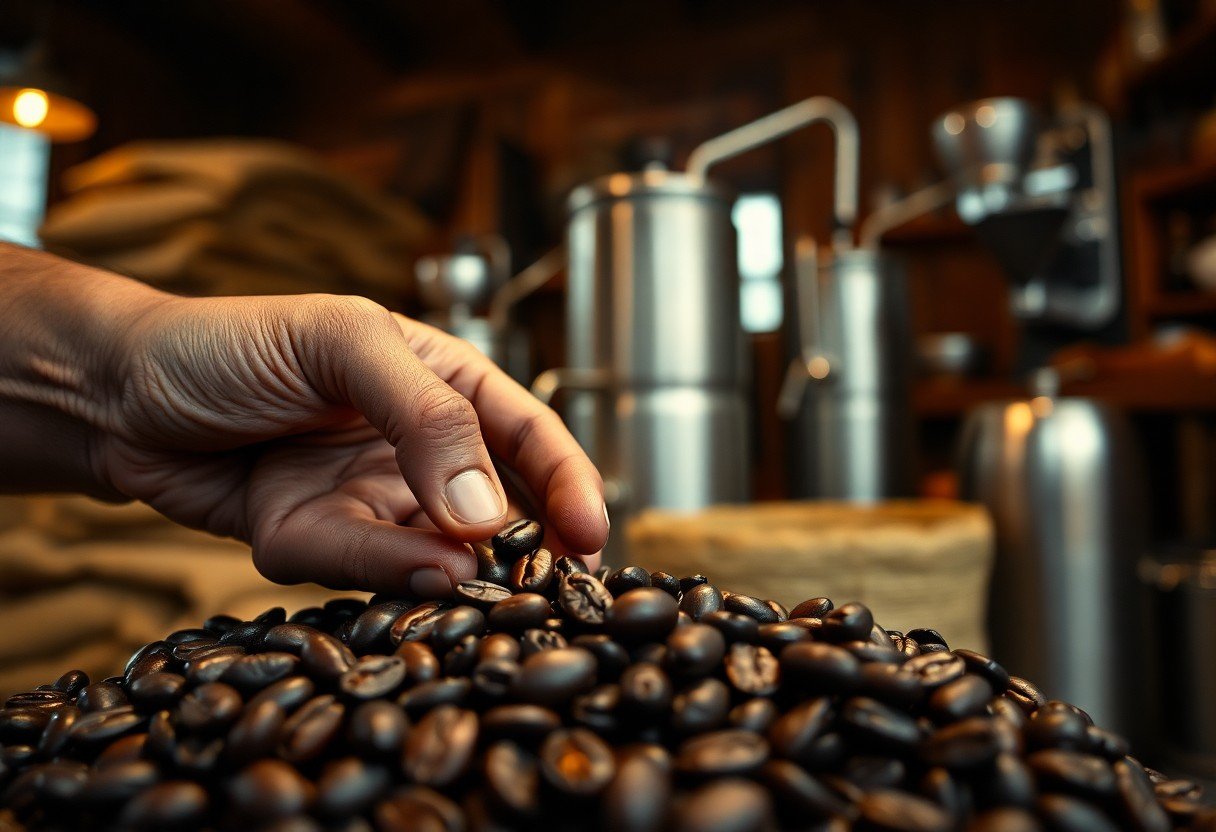Coffee enthusiasts know that the right beans can transform a simple cup into an extraordinary experience. When you’re shopping for fresh roasted coffee, it’s imperative to know how to identify quality beans among the many options available. In this post, you’ll learn key indicators to look for, from aroma to packaging, ensuring that every purchase brings you one step closer to your ideal brew. Get ready to elevate your coffee game and make informed choices that delight your palate!
Understanding Coffee Roasting
The quality and flavor of your coffee depend significantly on the roasting process. This is where green coffee beans are exposed to heat, transforming their chemical composition and bringing out distinctive aromas and tastes that define various coffee profiles. Understanding the nuances of roasting can empower you to select the highest quality beans when you shop.
The Roasting Process
Understanding the roasting process involves recognizing the stages that coffee beans go through. Initially, green beans are heated, leading to a range of chemical reactions known as the Maillard reaction. This process enhances flavor and color, creating that beloved aroma of fresh coffee. Careful monitoring of temperature and time ensures that beans reach their desired roast level.
Types of Roasts
Different types of roasts can impact your coffee’s taste and intensity profoundly. A basic understanding of these types will guide you in selecting the right beans for your preference. Here’s a breakdown:
- Light Roast: Retains the original flavor profile of the bean.
- Medium Roast: Balances acidity and flavor, giving a richer taste.
- Medium-Dark Roast: Develops additional sweetness and body.
- Dark Roast: Offers bold, deep flavors, often with a smoky undertone.
- French Roast: Burnt flavors dominate this very dark option.
After familiarizing yourself with the types, you can better choose coffee that suits your palate.
| Type | Description |
| Light Roast | Bright acidity with pronounced floral and fruity notes. |
| Medium Roast | A balance of acidity and body, often with chocolate undertones. |
| Medium-Dark Roast | Rich and sweet flavors, often with a hint of spice. |
| Dark Roast | Deep, bold flavors with a strong aroma and less acidity. |
| French Roast | Very dark and smoky, with a bitter taste. |
For instance, selecting a roast type aligns with the flavors you enjoy most. Each roast type further enhances specific attributes of the coffee, whether it’s the brightness of a light roast or the deep richness of a dark roast. Understanding these distinctions is imperative to making informed choices while shopping for your next batch.
- Roast level affects caffeine content; lighter roasts have slightly more caffeine than dark roasts.
- The aroma can vary significantly across roast types, influencing your coffee experience.
- Flavor profiles will appeal differently based on personal preferences and brewing methods.
- Origin plays a role in how the roast affects flavor, as specific beans lend themselves to certain styles.
- After considering all these factors, you’ll be equipped to make better selections.
| Parameter | Impact |
| Caffeine Level | Lighter roasts typically contain more caffeine. |
| Flavor Complexity | A light roast highlights original bean notes more than dark roasts. |
| Aroma | Different roast levels create distinct aromatic profiles. |
| Body | Dark roasts tend to have a heavier body compared to light roasts. |
| Aftertaste | Dark roasts may leave a more bitter aftertaste than lighter options. |

How to Identify Quality Beans
If you want to find exceptional coffee beans, look for distinct characteristics that indicate their quality. High-quality beans often stand out in terms of appearance, smell, and taste. Pay attention to the details, as these factors can significantly affect your coffee experience.
Visual Inspection Tips
Little do many realize, a simple visual inspection can reveal much about coffee bean quality. Look for the following indicators:
- Uniform size and shape
- Rich, consistent color
- Avoidance of defects like cracks or blemishes
After observing these aspects, you will have a clearer idea of the beans’ potential for brewing a delightful cup.
Aroma Assessment
Assuming you’ve selected your beans, the next step is to evaluate their aroma, which plays a vital role in your coffee’s overall flavor. Freshly roasted beans should emit a rich, inviting scent that hints at their flavor profile.
Assessment of aroma starts with a gentle swirling of the beans in your hands, allowing their scent to fill the air. Inhale deeply to catch underlying notes such as floral, fruity, or nutty fragrances. A fresh roast will trigger vibrant, sweet, and sometimes even spicy notes, signaling quality. This aromatic evaluation is vital to ensure that the beans you select will provide a satisfying coffee experience.
Factors Influencing Quality
Some key factors determine the quality of fresh roasted coffee beans you find in shops. It’s imperative to evaluate these elements before making a purchase:
- Origin of the beans
- Freshness and date of roasting
- Roast profile
- Storage conditions
Any one of these elements can significantly impact your coffee experience.
Origin of the Beans
One of the primary factors to consider is the origin of the beans. Different regions produce unique flavor profiles and characteristics based on their climate, soil, and cultivation methods. For instance, beans from Ethiopia often have fruity notes, while those from Colombia are smoother and caramel-like. Understanding the source can help you choose beans that align with your flavor preferences.
Freshness and Date of Roasting
Any coffee enthusiast knows that freshness is vital for optimal flavor. The date of roasting can significantly affect the taste and aroma of your coffee. Freshly roasted beans retain their oils and compounds that contribute to the brew’s flavor profile.
For instance, coffee beans are best consumed within a few weeks of roasting. As time goes by, they lose their vibrant taste, turning stale and flat. Therefore, always check the roast date on the packaging—look for beans roasted within the last two weeks to ensure a delightful cup every time. This simple step will guarantee you enjoy your coffee at its peak freshness and flavor.
Choosing Beans in Shops
All you need is a keen eye and a bit of knowledge to find quality coffee beans in shops. Look for beans that display a rich color and are consistent in size, as irregularities can indicate inferior quality. Consider checking out How to Identify High-Quality Coffee Beans for additional insights into selecting the best beans available.
Reading Labels and Certifications
Little details on packaging can reveal a lot about the coffee you choose. Look for labels that indicate the roast date, origin, and certifications like organic or fair trade, which can add to the quality assurance of the beans you purchase.
Asking the Right Questions
You should always engage with the staff and ask questions about the coffee’s origin, roasting methods, and freshness. Understanding these aspects can elevate your coffee experience and help you make an informed choice.
Reading about the specifics directly from knowledgeable staff adds value to your selection process. Inquire about the roast date, flavor profiles, and brewing recommendations. This dialogue not only enhances your understanding but also ensures you pick beans that suit your taste preferences. A little engagement can lead to that perfect cup of coffee you’re aiming for.
Brewing Techniques for Optimal Flavor
Unlike many believe, the art of brewing coffee goes beyond simply pouring hot water over grounds. By mastering various brewing techniques, you can unlock a spectrum of flavors, aromas, and nuances in your fresh roasted coffee beans. Choosing the right method will elevate your coffee experience, making each cup a distinct and flavorful journey. Experimenting with brewing times, temperatures, and techniques will empower you to discover what best suits your taste.
Brew Methods to Enhance Quality
If you want to enhance the quality of your coffee, experimenting with different brew methods is key. French press, pour-over, and Aeropress, for instance, each offer unique extraction profiles that bring out different flavors from your beans. Testing various techniques can help you pinpoint the method that yields the best taste according to your preferences.
Importance of Water Quality
An often overlooked aspect of brewing is the quality of the water you use. Using filtered water can dramatically affect the taste of your coffee, as impurities can alter the flavor profile. Quality water ensures that the inherent characteristics of the beans shine through in your cup.
Plus, the mineral content of your water plays a significant role in how well your coffee extracts. Ideally, you want water that is balanced with minerals to enhance flavor without overpowering it. Consider using water with a neutral pH and clear taste to truly appreciate the subtleties in your fresh roasted coffee. Making this small adjustment can lead to a more satisfying and enjoyable brew.
Storing Coffee Beans
Despite the joy of selecting fresh roasted coffee, proper storage is crucial to maintain its flavor. To keep your beans fresh, store them in a cool, dark place, away from moisture and air exposure. For more insights on selecting quality coffee, check out Why High Quality Beans Make a Difference.
Best Practices for Freshness
You should always store your coffee beans in an airtight container to minimize exposure to oxygen. Keeping the container in a pantry or cupboard, away from direct sunlight, will further help preserve their freshness. Try to buy only the amount of beans you can consume within a few weeks for the best flavor experience.
Avoiding Common Storage Mistakes
Coffee is sensitive to its environment, and improper storage can lead to stale or flavorless beans. Avoid keeping your beans in the fridge or freezer unless they are vacuum-sealed, as moisture can ruin their quality. Do not use a clear container for storage, as light can degrade the flavor compounds.
Mistakes can easily occur when storing coffee beans, especially if you treat them like other pantry items. Using the original packaging often leads to air exposure, which accelerates oxidation. Additionally, storing them near spices or strong odors can cause them to absorb unwanted flavors, adversely affecting your coffee. Always prioritize a dedicated, dark, and cool space for your beans.
Final Words
To wrap up, identifying quality fresh roasted coffee beans in shops involves paying attention to several key factors. Look for the roast date on the packaging, as fresher beans will enhance your coffee experience. Notice the aroma and texture; quality beans should have a rich, inviting smell and a slightly oily sheen. Additionally, choose beans that are sourced from reputable origins and consider specialty roasts for optimal flavors. By applying these insights, you can ensure that your coffee selections elevate your daily brew to new heights.

